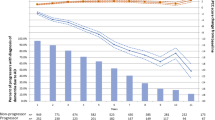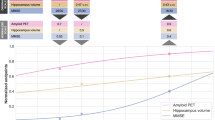Abstract
We are launching the Insights to Model Alzheimer’s Progression in Real Life study in parallel with the Alzheimer Prevention Initiative Generation Program. This is a 5-year, multinational, prospective, longitudinal, non-interventional cohort study that will collect data across the spectrum of Alzheimer’s disease. The primary objective is to assess the ability of the Alzheimer’s Prevention Initiative Cognitive Composite Test Score and Repeatable Battery for the Assessment of Neuropsychological Status to predict clinically meaningful outcomes such as diagnosis of mild cognitive impairment or dementia due to Alzheimer’s disease, and change in Clinical Dementia Rating–Global Score. This study is the first large-scale, prospective effort to establish the clinical meaningfulness of cognitive test scores that track longitudinal decline in preclinical Alzheimer’s disease. This study is also expected to contribute to our understanding of the relationships among outcomes in different stages of Alzheimer’s disease as well as models of individual trajectories during the course of the disease.

Similar content being viewed by others
References
Prince M, Comas-Herrera A, Knapp M, Guerchet M, Karagiannidou M. World Alzheimer Report 2016: Improving healthcare for people living with dementia - coverage, quality and costs now and in the future. London: Alzheimer’s Disease International; 2016. https://doi.org/www.alz.co.uk/research/WorldAlzheimerReport2016.pdf
Wimo A, Guerchet M, Ali GC, et al. The worldwide costs of dementia 2015 and comparisons with 2010. Alzheimers Dement 2017;13:1–7.
Reiman EM, Quiroz YT, Fleisher AS, et al. Brain imaging and fluid biomarker analysis in young adults at genetic risk for autosomal dominant Alzheimer’s disease in the presenilin 1 E280A kindred: a case-control study. Lancet Neurol 2012;11:1048–1056.
Dharmarajan TS, Gunturu SG. Alzheimer’s disease: a healthcare burden of epidemic proportion. Am Health Drug Benefits 2009;2:39–47.
Ashford JW, Mortimer JA. Non-familial Alzheimer’s disease is mainly due to genetic factors. J Alzheimers Dis 2002;4:169–177.
Bertram L, Tanzi RE. Thirty years of Alzheimer’s disease genetics: the implications of systematic meta-analyses. Nat Rev Neurosci 2008;9:768–778.
Gomez-Isla T, West HL, Rebeck GW, et al. Clinical and pathological correlates of apolipoprotein E epsilon 4 in Alzheimer’s disease. Ann Neurol 1996;39:62–70.
Raber J, Huang Y, Ashford JW. ApoE genotype accounts for the vast majority of AD risk and AD pathology. Neurobiol Aging 2004;25:641–650.
Bonham LW, Geier EG, Fan CC, et al. Age-dependent effects of APOE epsilon4 in preclinical Alzheimer’s disease. Ann Clin Transl Neurol. 2016;3(9):668–77.
Qian J, Wolters FJ, Beiser A, et al. APOE-related risk of mild cognitive impairment and dementia for prevention trials: An analysis of four cohorts. PLoS Med. 2017;14(3):e1002254.
Lopez Lopez C, Caputo A, Liu F, Riviere ME et al. The Alzheimer’s Prevention Initiative Generation Program: Evaluating CNP520 Efficacy in the Prevention of Alzheimer’s Disease. J Prev Alzheimers Dis. 2017;4(4):242–246.
Farias ST, Mungas D, Reed BR et al. The measurement of everyday cognition (ECog): scale development and psychometric properties. Neuropsychology. 2008;22(4):531.
Rosen WG, Mohs RC, Davis KL. A new rating scale for Alzheimer’s disease. Am J Psychiatry. 1984;141:1356–1364.
Kaufer D, Cummings J, Ketchel P, Smith V, MacMillan A, Shelley T, et al. Validation of the NPI-Q, a brief clinical form of the Neuropsychiatric Inventory. J Neuropsychiatry Clin Neurosci. 2000;12:233–239.
Bédard M, Molloy DW, Squire L, Dubois S, Lever JA, O’Donnell M. The Zarit Burden Interview: a new short version and screening version. The gerontologist. 2001;41(5):652–7
Wimo A, Jonsson L, Zbrozek A. The Resource Utilization in Dementia (RUD) instrument is valid for assessing informal care time in communityliving patients with dementia. The journal of nutrition, health & aging. 2010;14(8):685–90.
Van Hout B, Janssen MF, Feng YS, Kohlmann T, Busschbach J, Golicki D, Lloyd A, Scalone L, Kind P, Pickard AS. Interim scoring for the EQ-5D-5L: mapping the EQ-5D-5L to EQ-5D-3L value sets. Value in Health. 2012;15(5):708–15.
Torisson G, Stavenow L, Minthon L, Londos E. Reliability, validity and clinical correlates of the Quality of Life in Alzheimer’s disease (QoL-AD) scale in medical inpatients. Health and quality of life outcomes. 2016;14(1):90.
Lloret-Villas A, Varusai TM, Juty N, et al. The impact of mathematical modeling in understanding the mechanisms underlying neurodegeneration: evolving dimensions and future directions. CPT Pharmacometrics Syst Pharmacol 2017;6:73–86.
Ritchie CW, Molinuevo JL, Truyen L, et al. Development of interventions for the secondary prevention of Alzheimer’s dementia: the European Prevention of Alzheimer’s Dementia (EPAD) project. The Lancet Psychiatry. 2016;3(2):179–86.
Moulder KL, Snider BJ, Mills SL, Buckles VD, Santacruz AM, Bateman RJ, Morris JC. Dominantly Inherited Alzheimer Network: facilitating research and clinical trials. Alzheimer’s research & therapy. 2013;5(5):48.
Author information
Authors and Affiliations
Corresponding author
Electronic supplementary material
Rights and permissions
About this article
Cite this article
Graf, A., Risson, V., Gustavsson, A. et al. Assessment of Clinical Meaningfulness of Endpoints in the Generation Program by the Insights to Model Alzheimer’s Progression in Real Life (iMAP) Study. J Prev Alzheimers Dis 6, 85–89 (2019). https://doi.org/10.14283/jpad.2018.49
Received:
Accepted:
Published:
Issue Date:
DOI: https://doi.org/10.14283/jpad.2018.49




